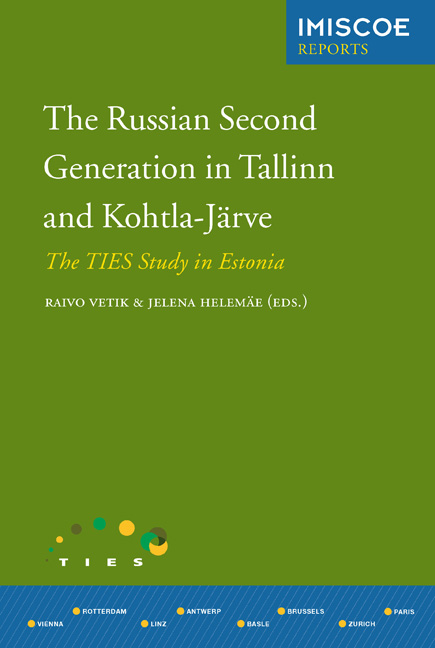Book contents
- Fronmatter
- Contents
- Preface
- List of Tables, Figures and Chapter Appendices
- 1 Introduction
- 2 Migration Patterns
- 3 Integration Policies
- 4 Ethnic Inequalities in Education
- 5 Explaining Different Returns from Human Capital in the labour Market
- 6 Income Inequality
- 7 Housing Conditions Andneighbourhood Satisfaction
- 8 Contact and Crisis in Interethnic Relations
- 9 Gender role Attitudes
- 10 Sense of Belonging to Estonia
- 11 Conclusions
- Appendix
- List of Contributors
- Other IMISCOE Titles
8 - Contact and Crisis in Interethnic Relations
Published online by Cambridge University Press: 20 January 2021
- Fronmatter
- Contents
- Preface
- List of Tables, Figures and Chapter Appendices
- 1 Introduction
- 2 Migration Patterns
- 3 Integration Policies
- 4 Ethnic Inequalities in Education
- 5 Explaining Different Returns from Human Capital in the labour Market
- 6 Income Inequality
- 7 Housing Conditions Andneighbourhood Satisfaction
- 8 Contact and Crisis in Interethnic Relations
- 9 Gender role Attitudes
- 10 Sense of Belonging to Estonia
- 11 Conclusions
- Appendix
- List of Contributors
- Other IMISCOE Titles
Summary
Introduction
Interethnic relations in Estonian society have been the subject of a large body of academic literature. These works have progressed from predicting the outbreak of violence between ethnic groups in the early 1990s to explaining Estonia as a perplexing case of non-violence (see Barrington 1995; Brubaker 1998; Chin & Kaiser 1996; King & Melvin 1999; Laitin 1998; Melvin 1995; Pettai & Hallik 2002; Smith 1996, 1999; Vetik 2001). The peaceful nature of interethnic relations was disrupted by the violent riots that broke out in Tallinn in April 2007, following the removal of the Bronze Soldier statue, a Soviet World War II memorial, from downtown Tallinn. In the two nights of rioting, on 26 and 27 April, over a hundred people were injured, one man was killed and close to 900 were taken into custody or detained for questioning. The riots were the first instance of large-scale violence since Estonia gained its independence. While the majority of the rioters were ethnic Russians, ethnic Estonians did join in the trouble and looting. Nevertheless, there was a clear interethnic conflict dimension to the crisis. The events preceding the crisis, including conflicts between Estonians and Russians at the site in previous years, as well as the government's handling of the statue's removal, produced interethnic tensions in Estonian society. Sociological studies carried out in the wake of the crisis demonstrate its profoundly negative effect on interethnic relations in Estonian society. The crisis has reawakened interest in interethnic relations and tolerance in Estonian society and has sparked a reassessment of the approach taken toward integration by the Estonian government (Ehala 2009; Korts 2009; Laristin & Vihalemm 2008).
The outbreak of violence in 2007 led to criticism of government integration policies. In response to pressure from the international community, particularly European institutions, the Estonian government developed a national strategy for minority integration (2000-2007). Both the integration programme (2000-2007) and its successor (2008-2013) have prioritised Estonian language learning among the Russian minority in the hopes of reducing the number of stateless persons, over the need to cultivate tolerant attitudes among ethnic groups (Korts 2009: 122). Recent studies have shown divergent attitudes between minority and majority groups with respect to their expectations of integration (Lauristin & Vihalemm 2008).
- Type
- Chapter
- Information
- The Russian Second Generation in Tallinn and Kohtla-JärveThe TIES Study in Estonia, pp. 165 - 182Publisher: Amsterdam University PressPrint publication year: 2012



